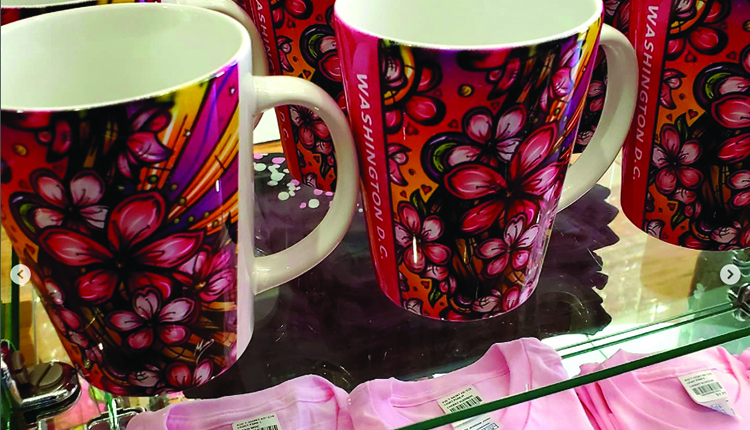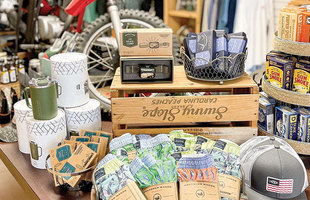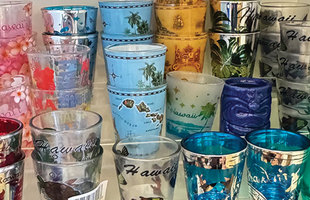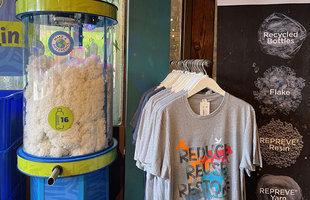Many customers come to Mayberry Market in Mount Airy, North Carolina, for the “Mayberry” memorabilia that is popular with Andy Griffith Show fans. Kaitlin Teague, co-owner of the store, says the Mayberry-themed souvenirs are particularly popular among people who grew up watching the show. She says a lot of customers are in their 70s and 80s, but some people in their 40s and 50s also come in hoping to buy Mayberry memorabilia for their parents or relatives. The store also features nearly 30 vendor booths with more general gift and boutique items to appeal to a wider age range and demographic.
Almost any souvenir bearing the store’s copyrighted Andy & Opie silhouette is a top seller at Mayberry Market. While customers come to the store for merchandise featuring that silhouette, they might also get a kick out of some impulse items the store offers. Teague says she keeps some Barney bullet keychains near the cash wrap, which often make guests smile or laugh and add it to their purchase.
Destination retailers like Mayberry Market can boost sales when they offer and promote impulse items to their customers. Although tourists usually come to gift and souvenir shops for keepsakes and memorabilia, retailers should stock travel accessories and essentials that these visitors might have forgotten to pack as a way to help the customer and boost sales.
Teague keeps some essentials up front for customers like pill holders or lip balm with the Mayberry logo.
“ChapStick is something you don’t think you’ll get here, but because it has the Mayberry logo on it, you get it,” she says.
Offer the unexpected
When retailers think about impulse items, they might initially think about keychains, mints, lip balm or other accessories customers might need. Customers certainly buy those types of products on an impulse, but an “impulse buy” isn’t just limited to the small knick-knacks that customers find at the cash wrap. An impulse buy can be just about anything a customer ends up buying that he or she didn’t intend to buy.
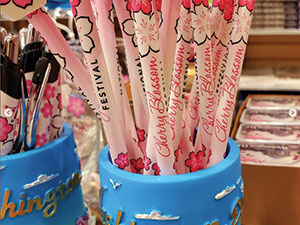
At King Street Souvenirs in Alexandria, Virginia, impulse buys celebrate cherry blossom season in nearby Washington, D.C.
Michael Hale, owner of Los Angeles-based Retail Rehab consulting firm, stresses that accessibility is key when it comes to impulse items. These products need to be easy for customers to grab and add to their purchase without much thought, such as a bin next to the cash register, a basket by the front door or a tray near a prominent display.
“An impulse item on the bottom shelf isn’t an impulse item,” he explains. “It has to be accessible.”
He adds that destination retailers can use adjacencies to boost these sales as well — place mugs close to coasters. A tourist might intend to come to a store to buy a souvenir mug, but seeing the coasters nearby will prompt them to add that onto their purchase.
Fontaine Stellas, owner of Souvenir City Chicago in the city’s Streeterville neighborhood, says she gets a decent number of customers coming into her shop who are visiting the city for a business trip. These customers often want to bring home souvenirs for kids and loved ones. She usually points those customers to a section of the store full of souvenirs for kids.
By stocking a bunch of souvenirs together, customers end up buying multiple souvenirs for their children back home.
“We have a lot of things that are easy to pick up for parents or grandparents buying for kids,” says Stellas. “I always try to help them figure out what to buy kids.”
Tourists are also drawn to Souvenir City Chicago for its Bean-themed window display. Although those customers come in to purchase a Bean-themed souvenir to remember their trip, Stellas says other items in her store catch their eyes as they shop around.
“We have a huge dog section,” she says. “People don’t come in looking for this, but they see it and buy for their dogs.”
Souvenir City Chicago customers are also surprised to find out the retailer has some local liquors as souvenirs, too. Stellas explains that she initially started her storefront as a liquor store called UnCorkIt. When she realized there weren’t many souvenir stores nearby, she decided to dedicate part of the storefront to souvenirs about five years ago.
Although UnCorkIt is a separate business, Stellas offers some of the most popular liquors as souvenirs at Souvenir City Chicago. She notes that Malort is a very popular liquor in Chicago and always stocks some by the register for tourists who want to take some home as a souvenir.
“People hear about [Malort], they see that when checking out and they buy it,” Stellas says. “That’s an impulse item.”
She also likes to stock smaller travel products near the cash wrap to help tourists who might have forgotten to pack things like car chargers or sunglasses.
“We try to have some things people forget — car chargers, phone chargers,” says Stellas. “We have international travelers here, so we keep international adapters by the register. In the summer, we have suntan lotion and lip balm they might forget because they are traveling.”
Destination retailers also can boost add-on sales when they bundle items. Teague says Mayberry Market likes to promote gift baskets during holiday season that feature some popular souvenirs — a Mayberry-themed mug, a shot glass and a magnet.
“We’ll take items we know sell well and bundle them together,” she explains. “[Customers] might just want a mug, but now they see they can get all of this.”
Teague notes that her store sold out of bundled gift baskets during the 2022 holiday season and, as of press time, expected the same to happen during the 2023 holiday season as well. She says customers are more drawn to the pretty packaging than if the souvenirs were by themselves.
“Displays are important,” she says. “Find items that look pretty; people are drawn to that.”
Grab attention
Stocking impulse items at eye level is also a good idea. Hale of Retail Rehab notes that merchandise stocked at eye level sells best because those are products people will notice first. He says destination retailers should also consider stocking impulse items at focal points in the store.
“Is there a wall that when you walk in, everybody sees [and] whatever I put on that wall is a good seller? Those are great spaces for [merchandising],” he says.
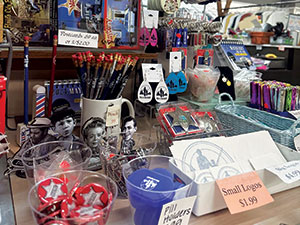
Small items grouped together at Mayberry Market in Mount Airy, North Carolina, encourage impulse buys.
In Alexandria, Virginia, King Street Souvenirs features a refrigerator stocked with sodas and other drinks close to the window to catch the attention of passersby. The destination retailer’s primary focus is selling Old Town Alexandria and Washington, D.C., themed souvenirs, but Manager Mai Ngo notes that having some drinks visible to passersby helps to draw some customers into the store on a hot summer day who might not have stopped in otherwise.
She says, “It gets people to walk in and then they say, ‘Oh, I have family and friends in town. Let me get them a gift’ or things like that.”
Ngo says King Street Souvenirs offers some other impulse items like snacks as well as outdoor accessories such as scarves and winter hats for customers.
It’s also important for destination retailers to take note of community events that might bring crowds to town. Teague of Mayberry Market shares that Mount Airy featured a Christmas parade during Thanksgiving weekend. Knowing there would be a lot of foot traffic by the shop, she says she placed some nice blankets by the store window with signage for paradegoers who might need to warm up.
“We knew they would be sitting outside. So we found some affordable [blanket] options for them,” she says. “A few hundred people came in [the store] to get warm, see if we had blankets.”
For other fall and winter events in Mount Airy, Teague says Mayberry Market has offered hot cocoa as well to get customers in the store. Often enough, those customers will end up buying more than just hot cocoa when they see a Mayberry-themed T-shirt they like or nice handbags in one of the boutique vendor booths.
Teague says she uses signage to try to catch customers’ attention as well.
“We put signs up for everything,” she says. “It doesn’t matter if you know that the item is a pill holder, we put a sign up for it. If they miss the product, they at least see the sign.”
Communicate with customers
Destination retailers shouldn’t just blindly guess at what products might make good impulse items and where to place them — they need to do their homework. Hale recommends destination retailers can get some good ideas for impulse displays simply by shopping at big box stores.
“Look at the grocery store, the Hobby Lobby,” he notes. “Go into places that are different categories of business. They will spark ideas on finding what your impulse items are and how to set them up.”
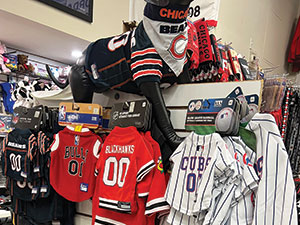
Associates on the sales floor help customers navigate gift selections at Souvenir City Chicago.
Regularly talking to customers to get a pulse on what they like and items they might forget on trips also can help destination retailers pinpoint key impulse items. Teague says she encourages her employees to pay attention and make note of what customers are looking for.
“Listen to what your customer wants,” says Teague. “If it’s a one-off thing, it might not be beneficial to buy. But if you constantly are hearing, even just a few times, ‘Do you have this?’ it might be beneficial to look into carrying that.”
Retailers can also boost impulse sales by suggesting items to customers as they shop. Stellas always makes sure Souvenir City Chicago customers are greeted and feel welcomed in her store. “We try to greet everyone and have someone floating to see if we can help them. Sometimes it’s giving them ideas for a gift or helping them find a collectible. We like to make them feel at home and seen.”
Talking to customers helps retailers get ideas for merchandising as well as boost sales in the meantime. Teague adds, “Listen to the people who shop with you and connect with them.”
